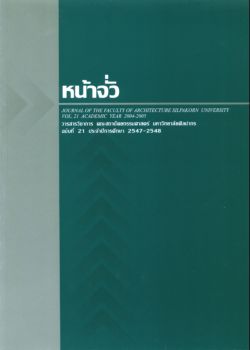ศูนย์กลางชุมชนกับวัฒนธรรมความยั่งยืน กรณีศึกษาชุมชนไทใต้คง ประเทศสาธารณรัฐประชาชนจีน
Keywords:
ศูนย์กลางชุมชน, วัฒนธรรม, ความยังยืน, Community center, Culture, SustainabilityAbstract
ชุมชนพื้นถิ่นในปัจจุบันที่คงอยู่มาจากอดีต ซึ่งมีอัตลักษณ์ทางชาติพันธุ์เป็นของตนเองและมีความเป็นอยู่ จากการปรับตัวและอยู่ร่วมกับธรรมชาติได้อย่างกลมกลืน ภาพลักษณ์เช่นนี้มักได้รับการกล่าวว่ามีความยั่งยืน พร้อมกับถูกยกให้เป็นชุมชนในอุดมคติเพื่อใช้เป็นเกณฑ์ในการพิจารณาว่าชุมชนอื่นมีหรือไม่มีความยังยืน แต่การนําเอาภาพลักษณ์จากอดีตมาใช้ตัดสินถึงความยั่งยืนในปัจจุบัน ย่อมเป็นบรรทัดฐานการตัดสินที่บิดเบือน ไปจากข้อเท็จจริง เนื่องจากชุมชนพื้นถิ่นหลายแห่งมักตกอยู่ในสภาวะที่ถูกห้อมล้อมจากคนต่างกลุ่มมากขึ้น ความยั่งยืนเฉพาะตนที่เคยมีอยู่ภายในกลุ่มจึงมักถูกสันคลอนให้มีปฏิสัมพันธ์กับกลุ่มชนวัฒนธรรมอื่นอย่างไม่อาจหลีกเลี่ยงได้หลายกรณี จึงมักพบว่าชุมชนที่สูญเสียเอกลักษณ์ไปพร้อมกับการกลืนกลายทางวัฒนธรรมคือความไม่ยั่งยืน แต่ในบางกรณีกลับพบว่าชุมชนบางแห่งสามารถที่จะมีความยั่งยืน อยู่บนบรรทัดฐานใหม่จากวัฒนธรรมอย่างใหม่ที่ตนนํามาใช้ การชี้วัดถึงความยั่งยืนจึงเป็นสิ่งที่เปราะบางแตกต่างกันออกไปในแต่ละบริบท โดยเฉพาะอย่างยิ่งกับการพิจารณาทางกายภาพ เช่น การตั้งถิ่นฐาน ลักษณะชุมชน และงานสถาปัตยกรรม ซึ่งต้องได้รับการพิจารณาถึงการรักษา อัตลักษณ์ควบคู่ไปกับการผสมผสานทางวัฒนธรรม อีกทั้งยังต้องพิจารณาถึงการเปลี่ยนแปลงหรือไม่เปลี่ยนแปลง ทางวัฒนธรรมในระดับใดที่ถือว่ายังคงมีความยั่งยืน
การศึกษาชุมชนไทใหญ่ ในหมู่บ้านน่าสี่ชุน หมู่บ้านหั่นซ่า และหมู่บ้านต้าเติงฮั่น เขตใต้คง ประเทศสาธารณรัฐ ประชาชนจีน พบว่าภูมิทัศน์ที่เกิดขึ้นในประเด็นของทิศทางการวางในผัง ได้แสดงให้เห็นว่าศูนย์กลางชุมชนมีบทบาท ต่อการทําความเข้าใจกับการรักษาอัตลักษณ์และการผสมผสานทางวัฒนธรรม อีกทั้งการช่วงชิงตําแหน่งและบทบาท ศูนย์กลางชุมชนจากการพิจารณามิติทางกายภาพยังมีความเป็นไปได้ที่จะเป็นดัชนีในการบ่งชี้ถึงความยั่งยืนโดยพิจารณาถึงองค์ประกอบที่ครอบครองความเป็นศูนย์กลางทางจิตใจบนพื้นที่แห่งนี้หากส่งผลให้ปฏิสัมพันธ์ระหว่างมนุษย์กับธรรมชาติ เบี่ยงเบนออกไปจากการให้ความเคารพต่อธรรมชาติ การพึ่งพาตนเองโดยไม่รุกรานธรรมชาติ รวมถึงเบี่ยงเบนส่งผล ให้ความมั่นคงทางจิตใจลดน้อยลง ย่อมสามารถบ่งชี้ได้ว่าวิถีการดํารงตนที่มีร่วมกันของคนในชุมชนได้หักเหออกไป จากทิศทางของความยั่งยืน
The Community Centers and Sustainable Culture: Dehong Dai Community, China
The long existence of vernacular communities with their ethnic identities and their adaptation in conformity with the natural environment has been conceived of as an ideal model of sustainability. However, while the traditional model images in terms of settlement, community characteristics, and architecture have often been used to assess other communities concerningthe state of sustainability, the whole context of their cultural environment must not be ignored. This is because many vernacular communities have been infiltrated and influenced by other cultures. Therefore, while the state of sustainability should be created within their own community and among other communities, the matter of protecting their own identities and integrating other cultures are very important issues. In other words, the assessment of sustainability is quite a subtle matter since the context of each community is different.
From the study of Tai-Yai communities at Nasiechun, Hansa, and Tateanghun in Dehong Dai, China, it was found that according to the patterns of existing folk cultural landscapes which were based on tradition, particularly with reference to orientation, the community centers play very meaningful roles. Since these roles are implications of how the Dais preserved their own identities, assimilated other cultures, and established their community centers, it was therefore possible to use the community center as an indicator of sustainability. In fact, the community center has long been considered an essential part of the Daiway of life. Even though the location of the community center may be altered, it still has influence on the worldviews of those who reside within its embrace to respect and to protect the natural environment. As the status quo is preserved, it could be said that these Dai communities have reached the state of sustainability based on their own present culture.





